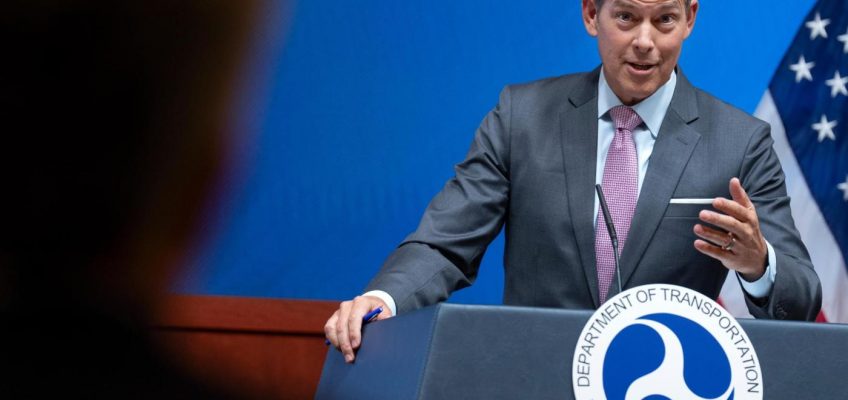By Mark Ellwood, Bloomberg News
Top interior designer Kelly Wearstler has been synonymous with a distinctively West Coast glamour — ’70s cool shot through with a liberal dose of Old Hollywood — ever since she established her namesake firm 30 years ago. A member of Architectural Digest’s Hall of Fame, the South Carolina native has overseen the design of hotels (Viceroy Santa Monica, Avalon Beverly Hills) and restaurants (at Bergdorf Goodman in New York), as well as partnering with Serax, the Rug Company, Hummer and other brands. She was the first outside designer tapped to create a new palette for the legendary British paint company Farrow & Ball.
Related Articles
What to know as US prepares to require REAL ID for many air travelers next month
The best new hotel in the world is in Denver, says Esquire
Worries about flying seem to be taking off. Here’s how to cope with in-flight anxiety
Here’s a sustainable travel hack: Shop at your local refill store
See the grandeur of our nation during National Park Week
Wearstler’s latest effort is the Substack-based newsletter Wearstlerworld, in which she plans to share behind-the-scenes looks at her life as well as tips and tricks for travel and decorating.
Wearstler logs around 150,000 air miles annually, pinballing back and forth between the West Coast (she lives in Beverly Hills) and Europe, and vacationing with her husband, developer Brad Korzen, and their three sons, Oliver, Elliott and Crosby, who are 20, 21 and 2½ years old. Her carrier of choice is Air France (but only if she absolutely has to go commercial). “Flying private is top of my list, of course, when it works out, but I really love Air France,” she says. “I just flew La Première to Paris. I was able to get upgraded from Business. You get taken right to the airplane. And in the first-class lounge in Paris, I recently had a six-hour layover, and I got a facial and a massage.”
Here are her best travel hacks (besides fly private, of course).
Checking luggage? Book two cars.
For the last 10 years, I have had two drivers pick me up when I land at LAX. I get off the plane and greet one driver and give him my luggage ticket. I leave, and he then waits to pick up my luggage at the carousel and drives it home. I get right out of there, and he shows up 45 minutes later. Wherever you go regularly and know a driver, you can do that — like in Austin, where I know my driver too.
Don’t mess with Uber et al. when you’re on a trip.
A hired driver is essential to getting around town with no time wasted. I always plan out my day so I’m super-efficient: a gallery, a studio visit with an artist, stopping in at a bookstore, going to museums and maybe a vintage clothing store for fashion. I have bags; I don’t want to lug that stuff around. I can just pop it in the car. And there’s no time f—ing around on your phone calling the Uber. I don’t book one through my hotel, because there’s usually a surcharge on it. There are limo services in every city, so you can just look online and call them.
Avid surfers should book a trip to this far-flung island.
One of my favorite off-the-beaten-path destinations is Nihi on Sumba Island in Indonesia. I’ve been going with my family since 2016 — we’ve been about six times. We fly to Bali to decompress, spend one or two nights, then fly to Sumba. It’s quite extraordinary, and the surfing waves are some of the best — all left breaks, which for me as a goofy-footed surfer is ideal. They tow you out, so you don’t have to paddle out every time you want to catch a wave. It’s effortless.
One pillow is for amateurs. Real pros travel with a full set.
I love to sleep really well when I travel. Six or seven years ago, I started bringing my three Frette pillows everywhere I go: two for my head, one to hug. I could easily get four or five in my carryon. I take out about 50% of the filling, because I want them really soft—I don’t want my face smushed at night. Some pillows at hotels are so hard, they’re like a sausage. These pillows can make any bed feel like my own. I consider myself a seasoned traveler, but I also hold on to my routines, especially on vacation.
Pack your beauty gadgets.
We travel with our red lights, because I do red light therapy on my face every day at home. Consistency, consistency — I’m all about consistency. The company, Joov, makes a travel size too, so I bring that with me, and I do that for 10 minutes before I go to sleep. It’s great in general, and great for your body, and it really relaxes you. I sleep so well. And six months ago, I started using this red light helmet for your hair from CurrentBody — red light for your hair follicles is like exercise.
This is the most stylish hotel she didn’t design herself.
I just had lunch with a friend at the Hotel Costes in Paris, and it’s spectacular. The two sides are so different, and it creates this beautiful tension. There’s the Jacques Garcia side, the old side, which is really beautiful. Then the restaurant sits in the middle. And then Christian Liagre did the other side.
Chartering a boat is the best family vacation.
A yacht charter is the best quality family time. You eat all your meals together, and you’re really, truly in the moment. We play chess, backgammon, we dive off the boat. You wake up together. At a hotel you’re in your separate rooms, but here you’re together the entire time. We’ve done Greece and Turkey that way, and we went scuba diving near Komodo Island.
The best destination for design junkies isn’t Copenhagen or Tokyo.
I have a gallery, and some of my artists are in Amsterdam, and it’s such a great city in terms of design. The Frozen Fountain has all these emerging Dutch artists, and right outside of Amsterdam is Morentz Gallery, in an old shoe factory. They are huge dealers in really great vintage furnishings. I’ve been buying from them for years. For restaurants, I love Cornerstore, because I get to absorb Amsterdam’s local music scene. Try the tasting menu.
Bring a second phone.
Over the last year, I’ve traveled with a backup iPhone. I lost my phone — I left it in a car. And then I had my phone taken. It happened twice, and it’s a hassle, so now I pack a backup one as part of my travel kit. It’s just a matter of getting it turned on. The secondary phone is already set up with my Apple ID and all of my iCloud data, so if anything happens to my main phone, I am able to log in to my service provider online and change the number over to the secondary phone. All you need is the EIN number, which is found in Settings/About on the iPhone, to transfer service over. It usually only takes 5 to 10 minutes to activate, which is so much faster than having to go to the Apple store to get a new one.
©2025 Bloomberg L.P. Visit bloomberg.com. Distributed by Tribune Content Agency, LLC.




